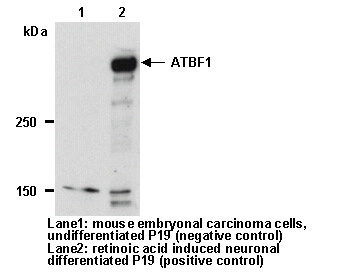Anti-ATBF1 (AT-6) (Human) pAb
| Code | Size | Price |
|---|
| MBL-PD011 | 100 ul | £323.00 |
Quantity:
Prices exclude any Taxes / VAT
Overview
Host Type: Rabbit
Antibody Isotype: Affinity Purified Ig
Antibody Clonality: Polyclonal
Regulatory Status: RUO
Target Species:
- Human
- Mouse
- Rat
Applications:
- Immunoprecipitation (IP)
- Western Blot (WB)
Shipping:
4°C
Storage:
-20°C
Images
Documents
Further Information
Applications:
WB - 1:1000-5000 (chemiluminescence detection system) IP - 2 uL/300-500 ug of protein
Background:
ATBF1 (also known as ZFHX3) is a transcription factor that has two-protein isoforms, the 404 kDa ATBF1-A and the 306 kDa ATBF1-B. ATBF1-A contains four homeodomains and 23 zinc-finger motifs. ATBF1-B contains four homeodomains and 18 zinc fingers. ATBF1 is identified as DNA-binding protein, which binds to an AT-rich element of the human α-fetoprotein (AFP) gene, as a result suppressing its transcription activity. ATBF1 is also involved in cell cycle arrest and cooperating with p53 to activate the p21Waf1/Cip1 promoter. ATBF1 is expressed in the differentiation fields in association with β-tubulin III and MAP2 that are the neuronal differentiation marker. ATBF1 plays a crucial role in neuronal development and cell cycle arrest.
Formulation:
100 ul volume of PBS containing 50% glycerol, pH 7.2. Contains no preservative.
Gene IDs:
Human: 463 Mouse: 11906 Rat: 307829
Immunogen Translated:
C-terminal region of mouse ATBF1 (3405-3549 aa)
Reactivity:
This antibody reacts with C-terminus region of ATBF1 on Western blotting and Immunoprecipitation.
Shelf Life:
1 year
Source:
This antibody was purified from rabbit serum by affinity column chromatography. The rabbit was immunized with recombinant C-terminus region of human ATBF1 corresponding to 3405-3459 aa.
Target:
ATBF1
References
1) Jung, C. G., et al., Development 132, 5137-5145 (2005)
2) Zhang, Z., et al., Clin. Cancer Res. 11, 193-198 (2005)
3) Ishii, Y., et al., J. Comp. Neurol. 465, 57-71 (2003)
4) Berry, F. B., et al., J. Biol. Chem. 276, 25057-25065 (2001)
5) Miura, Y., et al., J. Biol. Chem. 270, 26840-26848 (1995)




